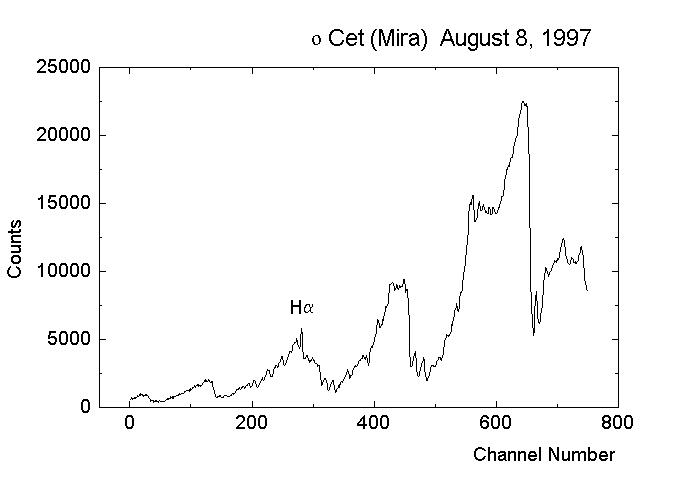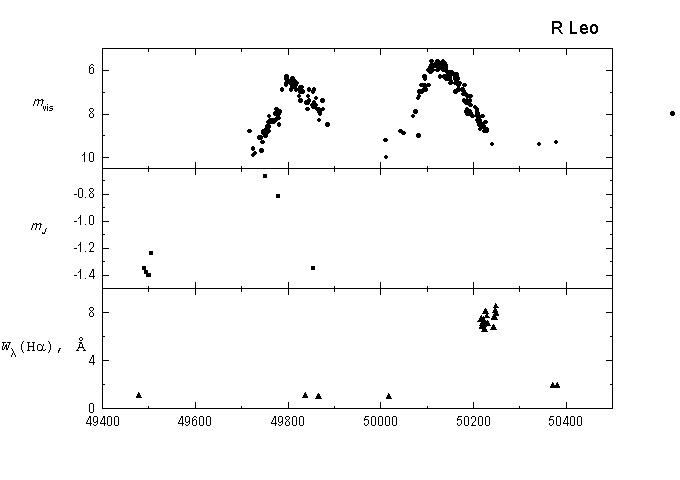Radio Astronomy Department
Sternberg Astronomical
Institute,
Moscow University


At present of great importance in astrophysics is the study of late evolutionary stages of intermediate-mass stars (of the order of 1-3 solar masses), in particular, the stars on the asymptotic giant branch (AGB). At this stage, stars intensely lose mass and, in about a hundred thousand years, pass from the red-giant stage to the stage 'white dwarf + planetary nebula'. This transition results in radical changes in star's structure. The matter, lost by the giant stars, forms thick gas-dust envelopes around the stars. Later, this matter goes to the interstellar medium, exerting a strong influence on the composition of the latter, especially on the interstellar dust. The AGB red giants are subject to pulsational instability; most of them are variable stars, belonging to the Mira Ceti type or to the semiregulars, with timescales of brightness variations of a few hundreds of days.
We are interested with the effects, connected with AGB stars' variability; in particular, with the phenomena due to passage of shock waves in the atmospheres and envelopes of the stars (shock waves are formed during each cycles of stars' light variations). The appearance of shock waves is signaled by presence of emission lines of hydrogen (Balmer series) and metals in stars' spectra. According to theoretical concepts, passage of shock waves should also cause radio continuum emission, both thermal and nonthermal (connected with acceleration of electrons on the shock front). Shock-induced nonthermal processes may lead to rapid (at timescales of a few hours) light variations within a few tenths of a stellar magnitude.
According to their chemical composition, red giant variables form two big groups: oxygen-rich and (less numerous) carbon-rich, of equal interest for us; oxygen-rich stars are also distingusihed with circumstellar maser emission of the OH, H2O, and SiO molecules.
Shock waves may influence the intensity of maser emission of the OH, H2O, and SiO in circumstellar envelopes - both directly (by impact of the shock on the maser generation region) and indirectly (through the radio continuum emission of the shock, amplified by masering molecules). There are reasons to suspect such a correlation.
We carry out the following observational programs within the framework of the project.
(1) Regular optical (UBV) monitoring of several Mira-type and semiregular variables (o Cet, chi Cyg, R Aql, R Leo, U Ori, U Her, RT Vir, R Cas, IK Tau, R Crt, RX Boo, W Hya; the list will be extended). The aim is to construct detailed light curves of the stars and to search for rapid light variations at some time intervals. The pre-maximum phases of the light curves deserve special attention, because at this time a developed shock is present in the stellar envelope, and strong nonthermal bursts are possible.
(2) Optical spectroscopy of the same stars at the phases, when emission lines of hydrogen and metals are present. Of special interest would be detection of rapid emission-line variability in Miras, as well as observations of emission lines in semiregular variables (for which there are only fragmentary data on emission-line observations).
(3) Radioastronomical spectral observations of maser emission of the same stars in 1.35-cm line of the H2O molecule. The aim is a detailed study of the maser emission variability. A search for new masers toward IR stars from the IRAS Point Source Catalog is carried out.
(4) IR observations of the stars, aiming to study the amplitude and character of the bolometric luminosity variations of the Miras; evaluation of the dust envelope parameters; tracing the correlation between IR and maser emission.
(5) Observations of the stars at centimeter wavelengths for a systematic search of the radio continuum emission, connected with the shock waves, and of the influence of the shocks and of the continuum on the molecular maser emission.
(6) Compilation and analysis of data on the light curves, optical spectroscopy, continuum and molecular maser emission for a broader sample of Miras and semiregular variables.
We carry out the spectral observations (2) by means of the grating spectrograph with CCD cameras ST-6, ST-6V, ST-8, and ST-402 manufactured by the Santa Barbara Instruments Group. This instrumentation has already been used in observations on the 70-cm telescope in Moscow and on 100- and 60-cm telescopes in the Crimea. In August 1997, test observations with an echelle spectrograph (resolving power 10,000) were performed in the Crimea. Below, a raw echelle spectrum of o Cet is shown.

Radio observations in the H2O line (3) are performed since 1980 on the 22-meter radio telescope of the Pushchino Radio Astronomy Station, Astrospace Center, Lebedev Physical Institute, Moscow Region, by means of the 1.35-cm wavelength receiver with a cooled FET preamplifier and a 128-channel filter-bank spectrometer, designed and constructed in the Sternberg Institute.
Radio continuum observations of miras (5) were carried out jointly with Dr. J.M.Chapman ( Australia Telescope National Facility) in November 1995 on the Australia Telescope Compact Array at 4.8 and 8.64 GHz. Out of 34 miras, only R Aqr was detected, the rest have upper limits between 0.16 and 0.66 mJy at both frequencies.
IR observations (4) are carried out on the Crimean telescopes, equipped with the IR photometer of the Sternberg Astronomical Institute.

Project Manager
V.F.Esipov
Some Links Related to Mira-Type Stars:
Postal Address:
Sternberg Astronomical InstitutePhone: 7-(495)-939 1030
Moscow State University
13 Universitetskij prospekt
Moscow V-234, 119234 Russia